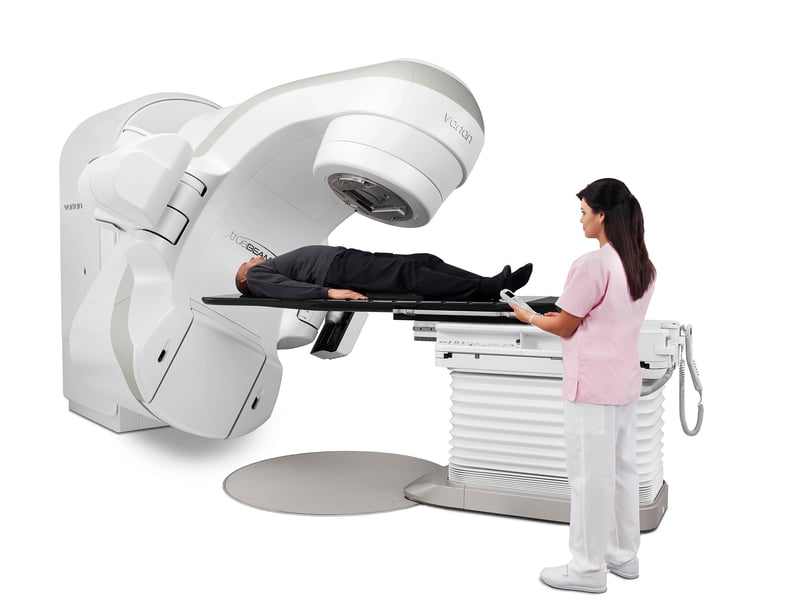
At Radiotherapy Clinics of Georgia, we are pleased to offer our patients in the Atlanta area access to the latest in radiation therapy, which now includes the TrueBeam™ system from Varian Medical Systems. This technology allows us to deliver more efficient treatment for cancer, including hard-to-reach tumors, for patients living in and around the area.
The TrueBeam linear accelerator system is one of the newest cutting-edge technologies in radiation therapy. With the ability to target tumors to the smallest millimeter, TrueBeam is a giant technological leap forward that is redefining external beam radiation therapy.
The unique sophistication of TrueBeam allows for the delivery of radiation doses from nearly any angle. Accurate, pinpoint radiation such as this makes it possible to target tumors precisely quickly while sparing the surrounding normal tissue. Speed, power, and precision make it possible to treat a broad range of normally hard-to-reach cancers. Sensitive, complex cancers, including lung cancer, breast cancer, prostate cancer, head and neck cancers, and colorectal cancer, can now be treated in a highly focused way that wasn’t available until now.
TrueBeam technology combines imaging, beam delivery, and sophisticated motion management to target tumors accurately and precisely with speed.
TrueBeam delivers a highly precise type of external beam radiation therapy called stereotactic radiation therapy. Stereotactic body radiation therapy (SBRT) is an advanced type of radiation therapy that delivers high doses of radiation using several beams of varying intensity. SBRT is used specifically for small, isolated tumors outside the brain and spinal cord. Stereotactic radiosurgery (SRS) is used to treat tumors located in the brain or spinal cord.
TrueBeam delivers radiation from a rotating machine that administers the prescribed amount from nearly any angle. Through an accessory called a multileaf collimator (MLC), the beams are shaped to match the 3D shape of the tumor. Conforming to the tumor in this manner helps minimize the dose of radiation to the surrounding healthy tissue, resulting in minimal to no damage. Combined with cone-beam CT real-time imaging, the radiation therapist can see the tumor without overexposing the patient to radiation.
TrueBeam was engineered with the patient in mind. Its innovative design and sophisticated technology offer several benefits that enhance the patient experience.
Patients receiving TrueBeam will receive treatment tailored to their needs. Various methods, including respiratory gating, imaging, real-time tracking, and more, help your radiation oncologist custom-design your treatment plan.
TrueBeam produces 3-D images that allow the radiation oncologist to target tumors precisely, with an accuracy measured in increments of less than a millimeter. It also reduces the required number of X-ray doses by 25%. Because of this, nearby vital organs and healthy tissue surrounding the tumor are less likely to be affected. With less exposure to the radiation beams and less damage to the nearby healthy cells, patients can expect fewer side effects, allowing them to feel better throughout their treatment. TrueBeam's respiratory gating technology aligns radiation delivery with the patient's breathing, to ensure that radiation is administered when the tumor is in the ideal position.
Compared to traditional radiation technologies, the TrueBeam system delivers radiation at a faster dose rate. This means shorter treatment times for patients. Typically, treatment times can be cut in half, with most only taking about a half-hour. Reduced treatment time allows many patients to return to normal activities quicker.
The TrueBeam system has several features that can help keep you safe, calm, and comfortable. Some ways these features can enhance the patient experience include:
Before you begin treatment, the radiation oncologists at Radiotherapy Centers of Georgia will develop a plan. Typically, this starts with tumor visualization — taking detailed 3D images of your tumor so we can know its size, shape, and location.
Based on the data gathered from the images, we will create a personalized plan that includes the amount of radiation the tumor should receive and from what angles. We will also use this time to create a treatment schedule.
When you come to the center for treatment, the radiation therapist will position you on the treatment table and ensure you are comfortable. To ensure no changes have occurred with the tumor since the planning appointment, another image will be taken.
During treatment, the machine will rotate around you at various angles. You and the therapist will be able to communicate at all times. While the initial setup may take some time, the process only takes a few minutes.
After treatment, you will see your cancer specialist for follow-up appointments.
While radiation therapy can cause side effects, they are often minimal. Please talk to your radiation specialist or another member of your cancer care team if you have any concerns.
Some patients may receive TrueBeam with other effective cancer treatments, such as chemotherapy or immunotherapy.
Radiotherapy Clinics of Georgia is happy to be one of the centers in Georgia treating patients with the highly effective approach of the TrueBeam radiation system. Our expert team of radiation oncologists in the greater Atlanta area is here to help you receive the quality treatment you need in less time.
Patients in the Atlanta area and surrounding cities can receive radiation therapy close to home. TrueBeam radiation therapy will be offered at our Conyers location. Request an appointment today to discuss your options with our radiation oncologists.

Radiation therapy is a commonly used cancer treatment, with more than half of cancer patients receiving it, it can be used in various ways depending on each patient’s needs. Our radiation guide includes common questions and what to expect when receiving radiation therapy.
Quickly and efficiently build the materials you need to support your inbound marketing strategy. Drag and drop building blocks including testimonials, forms, calls-to-action, and more.